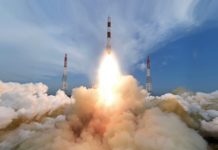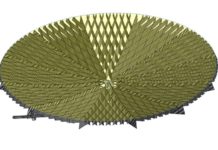This week, the scientific importance of both earth-based and space-based observatories was demonstrated when instruments all over the world detected the merger of binary neutron stars. This ground-breaking discovery, which marked the first time gravitational waves have been detected from such an event, was made possible not only because of astronomical technology, but also because of international collaboration and corroboration of data.
Here are Asia’s space observatories, most of which have been used to contribute to international efforts at astronomy and cosmology.
China
Dark Matter Particle Explorer (DAMPE), or Wukong
Named Wukong after Journey to the West’s fabled Monkey King, DAMPE is China’s first space observatory launched on 17 December 2015. A collaboration between universities in Italy, Switzerland, and China, DAMPE’s purpose is to detect high energy gamma rays, electrons and cosmic ray ions. Operating at a sun-synchronous orbit, it weighs approximately 1,900 kg, with five payloads including a neutron detector, an imaging calorimeter, and scintillator based hodoscope array. So far, DAMPE’s findings have not yet been published, although the Chinese Academy of Sciences (CAS) says it has collected a significant amount of data.
Hard X-ray Modulation Telescope (HXMT), or Insight
Launched in June 2017, HXMT is the second of China’s space telescopes and its first X-ray observatory weighing 2,800 kg. Also operating at a sun-synchronous orbit, it contains three major payloads – high, medium, and low energy X-ray telescopes. Its mission is to study transient X-ray sources on the galactic plane, examine strong gravitational or magnetic fields, and detect gamma-ray bursts. HXMT is generally regarded to be extremely useful in covering a large area; CAS recently announced the HXMT detected gamma ray bursts following international news of the neutron star merger, although details have not been revealed.
India
AstroSat
AstroSat is India’s only operational space observatory, launched on September 28 2015 to a Low Earth Orbit (LEO), and weighing 1,515 kg. Its six payloads are an Ultra Violet Imaging Telescope, a Soft X-ray imaging Telescope, a low-resolution X-ray imager known as the LAXPC Instrument, a gamma-ray burst detector the Cadmium Zinc Telluride Imager (CZTI), a Scanning Sky Monitor (SSM), and a Charged Particle Monitor (CPM). AstroSat is a multi-purpose observatory, aiming to study celestial sources in X-ray, optical and UV spectral bands simultaneously. AstroSat’s findings, especially in the field of gamma-ray burst detection, have been studied along with that of other space telescopes such as NASA’s Chandra and Hubble.
Japan
Hisaki, or SPRINT-A
A small satellite launched in September 2013, Hisaki is an ultraviolet astronomy satellite weighing only 340 kg, and was lofted on the maiden flight of Japan space agency JAXA’s solid fuel Epsilon rocket. With a design life of 1 year, the satellite is still operational today, four years on. Hisaki carries an extreme ultraviolet spectrometer to study the atmospheres and magnetospheres of the planets in our solar system, and is working with NASA’s Jupiter probe Juno to collect data. So far, the satellite has discovered the influence of solar winds on Jupiter’s inner magnetosphere, along with other characteristics of Jupiter such as its auroras.
Hinode, or SOLAR-B
Launched in September 2006, Hinode is a 700 kg satellite carrying two telescopes and one spectrometer, with an aim to study the magnetic fields of the sun. Developed jointly by Japan, the US, and the UK, with each instrument containing components from the three countries. Its SOT (Solar Optical Telescope), for example, contains a focal plane developed by Lockheed Martin, while its XRT (X-ray Telescope) was designed and built by Smithsonian Astrophysical Observatory (SAO). Besides providing valuable images, such as of the August 21 eclipse and a transit of Mercury across the sun, Hinode has also detected solar flares, and discovered that the sun’s 11-year cycle of polar field reversal occurs only at its North Pole.







